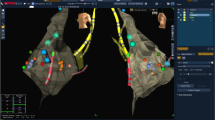Abstract
Aims
Some patients with documented episodes of paroxysmal supraventricular tachycardia (PSVT) do not have inducible tachycardia during the electrophysiological study. In this study, we describe how multiple low-temperature, low-power radiofrequency (RF) currents in the atrioventricular (AV) junction region can increase the rate of the induction of atrioventricular nodal reentrant tachycardia (AVNRT) in non-inducible cases.
Method
We enrolled 31 consecutive patients (mean age = 50.9 ± 11.9 years; 5 [16.1 %] male) who presented with documented clinical PSVT in superficial electrocardiography but had non-inducible arrhythmia in the electrophysiology laboratory despite applying different stimulation protocols. We delivered low-power (25 W), low-temperature (45 °C) RF currents into the AV junction region to induce AVNRT.
Results
Arrhythmia was induced in 20 (64.5 %) patients, and it was non-sustained in 3 (9.6 %) patients. RF current was delivered into the posterior region near the coronary sinus ostium and midseptal region. RF ablation target in inducible patients was the non-inducibility of the AVNRT at the end of the procedure, while the target in the non-inducible patients was slow pathway ablation with no antegrade conduction over the slow pathway. During the follow-up period, none of the patients (either with inducible or non-inducible arrhythmia) had recurrence of AVNRT.
Conclusion
Multiple low-power, low-temperature RF current application into the AV junction region is a more effective method for the induction of AVNRT in comparison with a single current use into the slow pathway.

Similar content being viewed by others
Abbreviations
- AV:
-
Atrioventricular
- AVNRT:
-
Atrioventricular nodal reentrant tachycardia
- IQR:
-
Interquartile range
- PSVT:
-
Paroxysmal supraventricular tachycardia
- RF:
-
Radiofrequency
References
Rostock, T., Risius, T., Ventura, R., Klemm, H. U., Weiss, C., Keitel, A., et al. (2005). Efficacy and safety of radiofrequency catheter ablation of atrioventricular nodal reentrant tachycardia in the elderly. Journal of Cardiovascular Electrophysiology, 16, 608–10.
Yaminisharif, A., Davoodi, G., Kasemisaeid, A., Farahani, A. V., Ghazanchai, F., & Moghaddam, M. (2010). Radiofrequency catheter ablation of atrioventricular nodal reentrant tachycardia: success rates and complications during 14 years of experience. The Journal of Tehran University Heart Center, 5, 87–91.
Huycke, E. C., Lai, W.-T., Nguyen, N. X., Keung, E. C., & Sung, R. J. (1989). Role of intravenous isoproterenol in the electrophysiologic induction of atrioventricular node reentrant tachycardia in patients with dual atrioventricular node pathways. The American Journal of Cardiology, 64, 1131–7.
Casta, A., Wolff, G. S., Mehta, A. V., Tamer, D., Garcia, O. L., Pickoff, A. S., et al. (1980). Dual atrioventricular nodal pathways: a benign finding in arrhythmia-free children with heart disease. The American Journal of Cardiology, 46, 1013–8.
Thapar, M., & Gillette, P. (1979). Dual atrioventricular nodal pathways: a common electrophysiologic response in children. Circulation, 60, 1369–74.
Bogun, F., Knight, B., Weiss, R., Bahu, M., Goyal, R., Harvey, M., et al. (1996). Slow pathway ablation in patients with documented but noninducible paroxysmal supraventricular tachycardia. Journal of the American College of Cardiology, 28, 1000–4.
Clyne, C. A., Athar, H., Shah, A., Kahr, R., & Rentas, A. (2007). Thermal mapping of right ventricular outflow tract tachycardia. Pacing and Clinical Electrophysiology, 30, 343–51.
Simmers, T. A., Bakker, J. M., Wittkampf, F. H., & Hauer, R. N. (1996). Effects of heating with radiofrequency power on myocardial impulse conduction: is radiofrequency ablation exclusively thermally mediated? Journal of Cardiovascular Electrophysiology, 7, 243–7.
Simmers, T. A., De Bakker, J. M., Wittkampf, F. H., & Hauer, R. N. (1995). Effects of heating on impulse propagation in superfused canine myocardium. Journal of the American College of Cardiology, 25, 1457–64.
Yamini Sharif, A., Vasheghani Farahani, A., Davoodi, G., Kazemisaeid, A., Fakhrzadeh, H., & Ghazanchai, F. (2011). A new method for induction of atrioventricular nodal reentrant tachycardia in non-inducible cases. Europace, 13, 1789–92.
Majewski, J. P., & Lelakowski, J. (2012). A new method for induction of atrioventricular nodal reentrant tachycardia: do we really need it? Europace, 14, 918–9.
Lindsay, B. D., Chung, M. K., Carolyn Gamache, M., Luke, R. A., Schechtman, K. B., Osborn, J. L., et al. (1993). Therapeutic end points for the treatment of atrioventricular node reentrant tachycardia by catheter-guided radiofrequency current. Journal of the American College of Cardiology, 22, 733–40.
Hummel, J. D., Strickberger, S. A., Williamson, B. D., Man, K. C., Daoud, E., Niebauer, M., et al. (1995). Effect of residual slow pathway function on the time course of recurrences of atrioventricular nodal reentrant tachycardia after radiofrequency ablation of the slow pathway. The American Journal of Cardiology, 75, 628–30.
Manolis, A. S., Wang, P. J., & Estes, N. (1994). Radiofrequency ablation of slow pathway in patients with atrioventricular nodal reentrant tachycardia. Do arrhythmia recurrences correlate with persistent slow pathway conduction or site of successful ablation? Circulation, 90, 2815–9.
Kay, G., Epstein, A., Dailey, S., & Plumb, V. (1992). Selective radiofrequency ablation of the slow pathway for the treatment of atrioventricular nodal reentrant tachycardia. Evidence for involvement of perinodal myocardium within the reentrant circuit. Circulation, 85, 1675–88.
Huang, S. K. S, & Wood, M. A. (2010). Catheter ablation of cardiac arrhythmias: expert consult: Elsevier Health Sciences.
Acknowledgments
This study was supported by Tehran Heart Center and Tehran University of Medical Sciences.
Author information
Authors and Affiliations
Corresponding author
Rights and permissions
About this article
Cite this article
Yaminisharif, A., Hoseini, S.M.S. & Shafiee, A. Multiple multisite low-temperature and low-power radiofrequency currents for the induction of atrioventricular nodal reentry tachycardia in non-inducible patients. J Interv Card Electrophysiol 42, 5–9 (2015). https://doi.org/10.1007/s10840-014-9955-2
Received:
Accepted:
Published:
Issue Date:
DOI: https://doi.org/10.1007/s10840-014-9955-2




